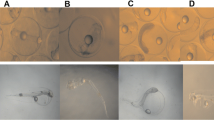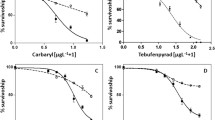Abstract
The mean static acute 96-h LC50 of permethrin [(3-phenoxybenzyl (+)cis, trans, 3-(2,2-dichlorovinyl)-2,2-dimethylcyclopropane carboxylate)] to red swamp crayfish (Procambarus clarkii) 8–12 mm (0.017 g), 25–35 mm (0.64 g), 45–55 mm (2.45 g), and 65–75 mm total length (8.98 g) was 0.44,0.85, 1.30, and 0.81 μg/L, respectively. Permethrin toxicity did not differ among immature or mature male and femaleP. clarkii. Crayfish surviving permethrin exposures exhibited no differences in post-exposure growth, survival, onset of sexual maturity, or the reproduction of viable young when compared to non-exposed controls. Teratogenisis was not observed in third-instar crayfish produced from permethrin-exposed parents.
Similar content being viewed by others
References
Abernathy CO, Casida JE (1973) Pyrethroid insecticides: esterase cleavage in relation to selective toxicity. Science 179:1235–1236
American Public Health Association (1985) Standard methods for the examination of water and wastewater. 16th Edition. APHA, Washington, DC
Boyd CE (1982) Water quality in warmwater fish ponds. Auburn Agricultural Experiment Station. Auburn University, Auburn, AL
Coulon DC (1982) Toxicity of Ambush® and Pydrin® to red crawfish,Procambarus clarkii (Girard) and channel catfish,Ictalurus punctatus (Rafinesque) in laboratory and field studies and the accumulation and dissipation of associated residues. Doctoral Dissertation, Louisiana State University, Baton Rouge, LA
Culley DD, Said MZ, Rejmankova E (1985) Producing soft crawfish: A status report. LSU Center for Wetlands Resources Publication, Louisiana State University, Baton Rouge, LA
Finney DJ (1971) Statistical methods in biological assay. 2nd Edition, Griffin Press, London
Gammon DW, Brown MA, Casida JE (1981) Two classes of pyrethroid action in the cockroach. Pestic Biochem Physiol 15:181–191
Guarino AM (1987) Aquatic versus mammalian toxicology: Applications of the comparative approach. Environ Health Perspect 71:17–24
Hicks CR (1973) Fundamental concepts in the design of experiments. 2nd Edition, Holt, Rinehart, and Winston, New York
Hodgson E, Levi PE (1987) A textbook of modern toxicology. Elsevier Publishing Company, New York
Huner JV, Barr JE (1984) Red swamp crawfish: Biology and exploitation. Sea Grant No. LSU-T-80-001, Center for Wetlands Resources, Louisiana State University, Baton Rouge, LA
Hymel TM (1985) Water quality dynamics in commercial crawfish ponds and toxicity of selected water quality variables toProcambarus clarkii. Master's Thesis, Louisiana State University, Baton Rouge, LA
Jewell CE, Winston GW (1989) Characterization of the microsomal mixed-function oxygenase system of the hepatopancreas and green gland of the red swamp crayfish,Procambarus clarkii, Comp Biochem Physiol 92:329–339
Jolly AL, Avault JW, Graves JB, Koonce KL (1977) Effects of Pounce® on newly hatched and juvenile Louisiana red swamp crayfishProcambarus clarkii (Girard). In: Papers from the Third International Symposium on Freshwater Crayfish at the University of Kuoppio, Finland. University of Kuoppio, Finland
Khan MA, Coello W, Khan AA, Pinto H (1972) Some characteristics of the microsomal mixed-function oxidase in the freshwater crayfish,Cambarus. Life Sci 11:405–415
Lee RF (1981) Mixed function oxidases (MFO) in marine invertebrates. Mar Biol Lett 2:87–105
Lindstrom-Seppa P, Koivusaari U, Hanninen O (1983) Metabolism of foreign compounds in freshwater crayfish (Astacus astacus L.) tissues. Aquat Toxicol 3:35–46
Lindstrom-Seppa P, Hanninen O (1986) Induction of cytochrome P-450 mediated monooxygenase reactions and conjugation activities in freshwater crayfish (Astacus astacus). Arch Toxicol Suppl 9:374–377
Matsumura F (1986) Toxicology of insecticides. 2nd Edition, Plenum Press, New York
Nishizawa Y (1971) Development of new synthetic pyrethroids. Bull WHO 44:325–336
Steel RG, Torrie JH (1980) Principles and procedures of statistics: A biometrical approach. 2nd Edition, McGraw-Hill, New York
United States Environmental Protection Agency (1975) Methods for acute toxicity tests with fish, macroinvertebrates, and am- phibians. EPA-600/3-75-009. Office of Research and Development, Corvallis, OR
Author information
Authors and Affiliations
Additional information
Approved for publication by the Director of the Louisiana Agricultural Experiment Station.
Rights and permissions
About this article
Cite this article
Jarboe, H.H., Romaire, R.P. Acute toxicity of permethrin to four size classes of red swamp crayfish (Procambarus clarkii) and observations of post-exposure effects. Arch. Environ. Contam. Toxicol. 20, 337–342 (1991). https://doi.org/10.1007/BF01064399
Received:
Revised:
Issue Date:
DOI: https://doi.org/10.1007/BF01064399




